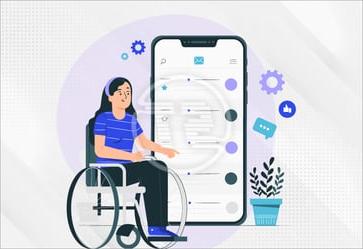October is Dyslexia Awareness Month, a time to celebrate the uniqueness of people with dyslexia and spread more awareness about it. The International Dyslexia Association (IDA) organizes several events throughout the month and displays various stories of dyslexic individuals. This is a period dedicated to increasing public understanding of dyslexia and the common learning differences among people in the spectrum and others.
With the rise of digital communication and technology playing an integral role in daily life, it is crucial to ensure that digital spaces are accessible to these dyslexic individuals. Since at times, organizations focus on vision and hearing-related accessibility practices and forget to include web accessibility for learning disorders that affect individuals suffering from dyslexia.
Read the article to learn more about Dyslexia Awareness Month.
Understanding dyslexia and digital barriers
Dyslexia affects approximately 10% of the global population. It is characterized by difficulties with reading, writing, spelling, and phonological processing. However, these challenges do not reflect intelligence or motivation; rather, they result from the way the brain processes language.
In the digital landscape, individuals with dyslexia may encounter several barriers.
- Text-heavy websites can feel overwhelming due to difficulties with decoding large blocks of text.
- Inconsistent fonts and formatting may reduce legibility and hinder comprehension.
- Poor contrast between text and background can cause visual strain, making it harder to read.
- Inaccessible navigation and layout complicate the user experience, as individuals with dyslexia may need more time and clarity to process information.
Fortunately, several strategies can be implemented by web developers, designers, and content creators to mitigate these challenges and ensure an inclusive online environment.
Best practices to ensure a web asset is inclusive for dyslexic users!
Use dyslexia-friendly fonts
Choosing the right font is essential for making text more readable for individuals with dyslexia. Sans-serif fonts, such as Arial, Verdana, and Tahoma, are generally easier to read. Additionally, specialized fonts like OpenDyslexic have been designed to improve readability by giving letters a heavier bottom, preventing the letters from flipping or rotating, a common issue for individuals with dyslexia.
All in One Accessibility® includes Dyslexia fonts and stop animation features for improving readable and personalized experience!
Break text into smaller chunks
Large blocks of text can overwhelm readers with dyslexia. To improve comprehension:
- Use short paragraphs and frequent line breaks.
- Employ bullet points or numbered lists to organize information.
- Keep sentences concise and straightforward, avoiding overly complex structures or jargon.
Provide alternative formats for content
Offering multiple formats for content allows users to choose how they prefer to consume information. For instance,
- Text-to-speech (TTS) tools that allow individuals to listen to content rather than reading it.
- Audiobooks or podcast versions of articles and blog posts.
- Video content that includes subtitles or transcripts.
Improve text contrast and backgrounds
Proper contrast between text and background can improve readability. Dyslexic users often struggle with low contrast, such as light grey text on a white background. To optimize contrast:
- Use dark text on a light background or vice versa.
- Avoid background patterns or images behind text.
- Allow users to customize background colors, as some individuals with dyslexia prefer softer hues such as beige or pastel backgrounds.
Prioritize clear, simple navigation
Websites should be easy to navigate, with logical, intuitive layouts. To enhance accessibility:
- Use consistent menus and ensure that important links are easy to find.
- Avoid dropdown menus with excessive options, as they can overwhelm users.
- Ensure all buttons are clearly labeled and use descriptive links such as “Learn more about dyslexia accessibility” rather than generic labels like “Click here”.
Incorporate readability tools
Readability tools can help users with dyslexia customize the way content is displayed. For instance, they offer adjustable font sizes and line spacing. Integrate tools like BeeLine Reader, which color-codes lines of text to guide the reader’s eyes and improve focus.
Provide visual aids and graphics
Supplement text with infographics, images, and icons to help convey meaning. Visual aids break up text and provide context clues, which can assist in understanding complex concepts. However, ensure that graphics are labelled with alt text for accessibility purposes.
Test website with dyslexic users
To create a truly inclusive experience, it is vital to gather feedback directly from individuals with dyslexia. User testing can help identify specific pain points and areas for improvement. Engage users with diverse needs to ensure the website is accessible and usable by a broad audience segment.
Accessibility beyond the web: A broader perspective!
“When we design for disability first, we often stumble upon solutions that are not only inclusive but also are often better than when we design for the norm.”
Thus, focusing on such disability-friendly web designs is always beneficial for organizations.
While web accessibility is essential, it is equally important to apply above-mentioned best practices across all digital platforms. Whether designing mobile apps, ebooks, or social media content, accessibility strategies should be adopted to ensure an inclusive experience.
Moreover, fostering inclusion is not just about technology; it is also about empathy and understanding. As we celebrate Dyslexia Awareness Month, let’s commit to building a more accessible digital world, where individuals with dyslexia can fully participate and thrive.
Skynet Technologies is a leading provider of comprehensive digital solutions for enterprises, and their commitment to website accessibility aligns with their ethos of inclusivity and innovation. By prioritizing WCAG compliance, we ensure that enterprise websites are accessible to all users, including those with disabilities. We recognize the significance of adhering to WCAG guidelines, not just for legal compliance but also for enhancing user experience. Their approach to enterprise website accessibility involves thorough audit, strategic planning, website accessibility remediation , consulting, document remediation, VPAT, self-assistance training, ongoing monitoring, and support that cater to diverse user needs. Request a quote or reach out [email protected].



